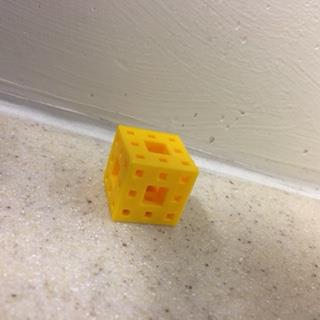
Above is the Fractal, the Sierpinski Carpet (abbreviated “carpet”). According to a Wikipedia article here, the carpet is one generalization of the cantor set to two dimensions, similar to the cantor dust (shown below). While I do not know what much of this means right now, I would be eager to learn in the future.


Going back to the serpinski carpet, the fractal repeats when nine squares appear, and the center one is removed, thus repeating to infinity (Source). This fractal was first developed by Wacław Sierpiński in 1916. Since then, the Carpet has remained relatively unchanged, except for one variation called the Wallis Sieve, which begins by dividing one square into nine, like the carpet. The next step is different though. In the carpet, those nine squares keep dividing into nine more into infinity. In Wallis Sieve, the first nine are then divided into twenty-five smaller squares into infinity.
While it may be a little tricky, as there is a sufficient amount of overhang, it will be possible to 3D print, as thingverse.com user taroh did so. Their 3D printed model is shown above. While I could not find a given size for this model, I am certain it could be 3D printed at many small and large sizes to accommodate both printer size and use of materials.
3D Printing Results

The image above is the result of when I attempted to 3D print the Sierpinski Carpet, or rather it’s 3D brother, the Wallis Sieve. It came out much better than I had expected. I posted my print on thingiverse, and the post can be found here. The printed object is in the 3rd “phase” or iteration of this design. Despite the apparently excessive amounts of overhang, and my predictions that it would be difficult to 3D print, it was actually fairly simple to do once I figured out how to save the file onto the SD card, it was simply a process of plug and print into the Ultimaker. The only area where I ran into trouble was trying to remove the print from the platform once it completed, as it had gotten stuck. The print took about 35-40 minutes to print, and while there are some small imperfections on the inside overhang, they are not too noticeable, and are minor enough to call this a successful print. I would definitely reccomend this a print to anyone looking for a new print.

Don’t forget to post a Make on Thingiverse and link to it here